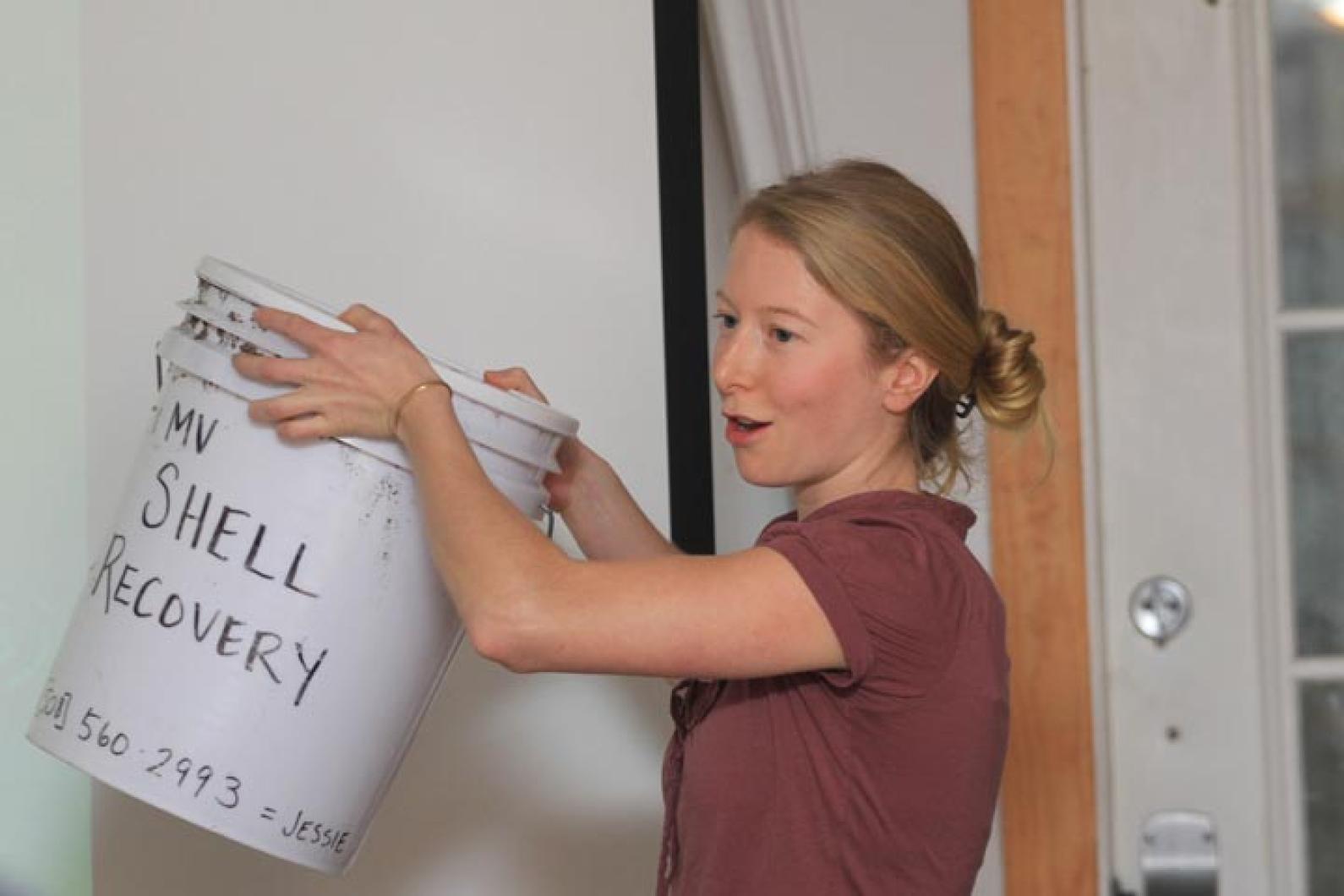Vineyarders are rightfully proud of the yearly abundance of oysters and scallops pulled from Island ponds, but little is made of what goes back into the water. Jessica Kanozak, creator of the Island’s nascent shell recovery program, hopes to change all that. After the first year of a pilot program on the Vineyard to return seashells to the sea, experts and community leaders met Saturday to discuss the program’s strengths, weaknesses and potential for expansion.
The benefits of returning shells to Island estuaries are multifold. Shells provide a substrate for oyster and scallop spat, or larvae, and a complex habitat for juvenile fish. They even affect the chemistry of their environment, buffering against acidic water that can corrode baby mollusks — a characteristic that is especially useful in the face of ongoing ocean acidification (in addition to warming the atmosphere, carbon dioxide reacts with ocean water to create carbonic acid, lowering the ocean’s pH).
“Nature intended for shellfish to make more shell and for the shell to stay in the habitat,” said Martha’s Vineyard Vision Fellow and Marine Biological Laboratory shellfish biologist Emma Green-Beach. “We’ve really disrupted this shell budget by the way that we’ve harvested.”
Boosting shellfish production has long been recognized as a panacea for much of what ails the Island ponds, most of which suffer from some degree of nutrient loading. Oysters filter up to 30 gallons of water a day, in doing so pruning the phytoplankton that prevents light from reaching valuable eelgrass beds and absorbing the nitrogen that feeds that growth. Any effort to make the ponds more habitable to shellfish could represent a dollar saved in sewering or other expensive habitat remediation projects.
Surprisingly, for a community seemingly teeming with shell resources, the Vineyard imports hundreds of cubic yards of shells every year, all while Island restaurants discard them by the thousands. The fact was not lost on Ms. Kanozak, a manager at the Offshore Ale House with a degree in aquaculture, and the recipient of a $6,315 Edey Foundation grant to launch an Island shell recovery program. The foundation provides grants to nonprofit organizations for conservation on Martha’s Vineyard.
But collecting shells from Island restaurants has proven to be a surprisingly difficult logistical challenge. Ms. Kanozak spent the summer juggling the shell refuse from half a dozen restaurants, retrieving some 6,121 pounds in all (1,696 pounds from Nancy’s alone, where shucker Joe Blais says that he shucks 2,500 oysters a week and another 1,000 clams). It was an exhausting summer for Ms. Kanozak, who shuttled around up-Island towns with her Subaru and makeshift trailer collecting the dedicated shell waste buckets that she provided restaurants. But one missed pickup or miscommunication could mean a load of putrid shells rotting on site, effectively sinking the program.
“It’s my job as a chef to really concentrate on product coming in, processing that product and then that product going out,” said Christian Thornton of Atria restaurant. “As a restaurateur you’re hit with these programs all the time, whether it’s slop for pigs or whatever. You try to participate but then there’s a break in the chain.”
On Saturday, Stephan Abel, the executive director of the Oyster Recovery Partnership in Maryland, described his own struggles launching and managing a cost-effective shellfish recycling program. So far the program, begun in 2010, has collected 10,800 bushels of oyster shells and enlisted the participation of almost 100 restaurants in the Baltimore-Washington D.C. area. Chesapeake Bay was once the world’s supplier of oysters, providing 15 million bushels a year, but by the early 1990s it was managing barely one percent of that production. Mr. Abel said that his program will not only help the ecology of the embattled embayment but bring a broader public awareness to its plight and recovery.
“This program really has solidified people’s understanding of what oysters do,” he said. “It’s amazing how much it has been embraced.”
Ms. Kanozak acknowledged the improvised nature of her first year at the helm of the Martha’s Vineyard Shell Recovery Program.
“I honestly didn’t ask the towns if we could do this program, because it’s easier to ask for forgiveness than permission,” she said. Martha’s Vineyard Shellfish Group director Rick Karney warned well-intentioned citizens not to take it upon themselves to restore the Island’s shell budget. Shellfish waste, which must first sit out on land for a year to be neutralized, can introduce harmful diseases to the ponds.
For the program to succeed it will require persistence and a broader conversation with the Island community. On Saturday, that discussion began as representatives from restaurants and waste disposal services discussed opportunities for collaboration in recovering the Island’s spent shells.
“The community really likes the idea of harvest-to-table and back,” said Ms. Kanozak. “This program is simple and it closes the loop.”







Comments (1)
Comments
Comment policy »